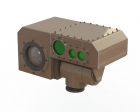Video Surveillance Systems: From Ancient Civilizations to the Modern Military from B2kholdings's blog
From the all-seeing eye to the sacred divider, surveillance has been a part of civilization since the beginning of time. Early cases of video surveillance systemsin antiquated societies have been found around the world, counting the numerous pyramids in Egypt and Mesopotamia.
In antiquated Egyptian civilizations, for example, sanctuary complexes were prepared with deliberately set watchtowers, which worked essentially like today’s checking towers or security operations centers (SOCs).
These early forms of observation were nothing like today’s cutting-edge airborne video recorders, but they did serve the comparative purpose of checking and securing individuals and property.

Industrial transformation and video surveillance systems
The mechanical transformation changed the perspective of society. With the rise of manufacturing plants, urbanization, and population development, there was a need for expanded security and control in industrialized areas.
Industrial insurgency innovations that laid the basis for video observation systems included:
The Electrical Telegraph: The innovation of electrical transmission by Samuel Morse empowered the transmission of messages over long distances utilizing electric signals. This laid the foundation for the future transmission of visual information.
Photography (1839):The innovation of photography by Louis Daguerre and William Henry Fox Talbot permitted the capturing and conservation of pictures. Photography served as a forerunner to video innovation, and its headways contributed to the improvement of video surveillance.
Electric Light (1879): Thomas Edison’s development of the down-to-earth glowing light bulb revolutionized lighting and amplified the operational hours of observation systems, empowering round-the-clock monitoring.
Motion Picture Camera (1891):The creation of the motion picture camera by Thomas Edison and William Kennedy Dickson cleared the way for creating video recording innovations utilized in video surveillance.
Early CCTV systems and applications
The CCTV system has come and travelled a long way since its origin. In the early days of CCTV systems, the innovation was simple and constrained in its capabilities. In any case, these early systems laid the foundation for the headway we see today.
As with numerous of today’s innovations, such as GPS, the Web, and cloud computing, the early days of CCTV systems had their roots in military and government applications.
World War II (1942): German military analysts created the CCTV system to screen plane runways at night and identify any damage.
Post-World War II (1949):U.S. temporary workers began creating and offering CCTV systems for use in the commercial and mechanical sectors.
State Security (1960):State security powers and police offices started utilizing CCTV as surveillance procedures. The first police office to utilize CCTV to screen open roads happened in Olean, Unused York, in 1968.
VCR technology and progress in CCTV systems
In 1972, security experts started to look at developing innovations, such as the VCR, for potential use in CCTV applications. In spite of the fact that it’s easy to see VCRs as an oddity gadget of the late 20th century, they were really a progressive piece of innovation that made a difference in opening the doorways for the future of video surveillance.
With the capacity to record and playback video, the security industry started to take note. Security service providers during the 1980s, started to offer CCTV systems for common and security use.
Role of CCTV producers in the advanced innovation of video surveillance
Leading producers of CCTV and long-range cameras have played a pivotal role in the history and advancement of video surveillance.
Multiplexing (1990s):In spite of the fact that it may sound essential nowadays, multiplexing was a major progression in video surveillance. It permitted numerous cameras to be controlled by a single recorder, permitting clients to see live and recorded film simultaneously.
Time-lapse and motion-only recording (1990s): Time-lapse recording, an essential feature that is now a standard in most modern systems, enabled the recording of film at a lower resolution and faster frame rate than live view.
IP-based CCTV systems (1990s):The first centralized IP camera, the Pivot Neteye 200, was released in 1996 by Pivot Communications. In spite of the fact that you can likely find one in an exhibition hall nowadays, this camera was a point of reference in the history of video surveillance.
Cloud-based CCTV systems (2010s): The cloud has changed everything, and video observation is no special case! With a cloud-based CCTV system, clients can get to their observation film anywhere at any time.

AdvancedVideo Surveillance Systems and Thermal Cameras
Artificial Intelligence (AI) Made in the 2010s, AI is continuously being utilized in warm cameras to recognize and track people and objects, as well as to recognize suspicious activity. This can help organizations improve their security as well as save cash by decreasing the number of false alarms.
AI Learning: Significant learning is a sort of AI especially laid out to analyze gigantic amounts of data. This makes it ideal for video perception frameworks, as it can recognize and track people and objects in complex and challenging environments.
Network video recorders (NVRs): NVRs are contraptions that store and direct video film on tough military shows from CCTV cameras. NVRs are getting to be more predominant as they offer a few focuses over ordinary DVRs, including way better picture quality, more critical capacity, and less requesting integration with other systems.
Video analytics:Video analytics is a computer program application that analyzes film from CCTV cameras. Video analytics can be utilized to recognize and track people and objects, as well as to recognize suspicious activities. This can help organizations advance their security, and it can also help them save cash by diminishing the number of unfaithful cautions.
Meanwhile, if you wish to contact the best defense contractors for video surveillance systems and other advanced gadgets, contact B2KHoldings.
The Wall